Two Months Post-Irma, We’re Still Learning
Back in September, Georgia pecan growers got to experience what it would be like to grow pecans on the Gulf Coast. Hurricane Irma followed Interstate 75 directly up the Florida peninsula into Georgia with sustained winds of 20-40 mph and gusts reaching from 50-75 mph, something our friends in Alabama, Mississippi, and Louisiana are all...
Read moreRemembering and Cherishing Pecan Memories
Unlike most Texans and Southerners, I only have a handful of pecan stories from my childhood. My grandparents didn’t have a tree. My mom didn’t really bake. So, we didn’t spend hours baking pecan pies or picking up pecans out in the backyard. But like many Americans, my first—pretty much all—my pecan memories come from...
Read more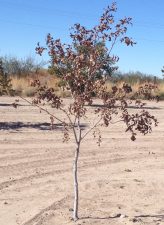
Not Just Cotton, Not Just Roots, Cotton Root Rot Affects Pecan Trees
Compared with our pecan-growing friends in the humid central and eastern production areas, we in the western states, fortunately, have very, very few plant disease issues that we struggle with on a regular basis in our pecan orchards. Sometimes I’ll even hear folks say that we don’t have any pecan diseases out here because it’s...
Read more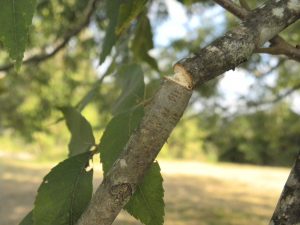
Twig Girdlers Frustrate Homeowners and Commercial Producers
Every fall I receive calls and emails concerning small severed twigs under pecan trees so this is a good time to address this issue. In my list of insects that feed on pecans, I have recorded 63 species that feed in the main trunk, branches, twigs and roots. Of these 63 species, 32 are beetles...
Read more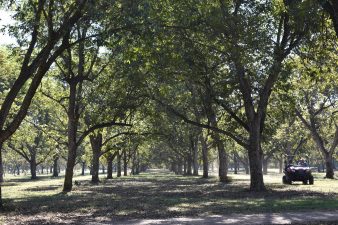
Where Heritage & Business Meet, the Choctaw Nation Grows Pecans
“I don’t want to say it just happened, but it kinda just happened,” says Doyle McDaniel, Tree Production Manager for the Choctaw Pecan Farms. He’s referring to the over 1,500 acres of pecan farmland that the Choctaw Nation now owns throughout Southeastern Oklahoma. In about two years, the Choctaw Nation has gone from an undisclosed...
Read more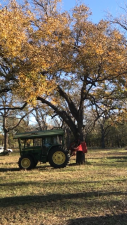
A Salute to the American Pecan Farmer
It’s November and there is, perhaps, no better Month to celebrate the American pecan farmer. After all, you are one to be celebrated! You are, most assuredly, in full swing harvesting your crop. You are short on daylight, and your days are long. And at times you may be lacking the help you need to get the job...
Read more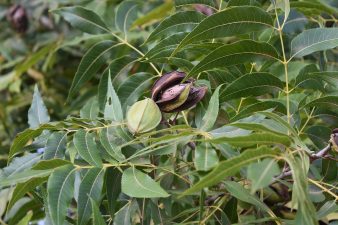
Pecan Pie: A Time-Honored Tradition
Thanksgiving is upon us yet again. It’s time to celebrate family and friends and to cherish all of the blessings in our lives. This American holiday wouldn’t be complete without a delicious pecan pie, which has become a symbol of the holiday season and the South. But how did it get that way? And who...
Read more“Son, Nitrogen Makes Plants Grow”
This week I told Monte Nesbitt, “Well, it looks like we’re going to have two short crops in a row.” I asked him what he thought. Smiling, he said, “They need a good dose of Ammonium nitrate.” We both laughed because we know one cannot go 15 years without soil-applied nitrogen fertilizer on bearing pecans....
Read more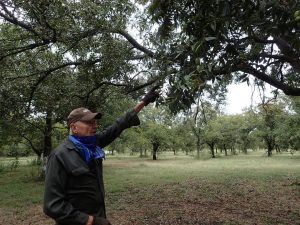
Remembering a True Pecan Man
Richard Louis Haller of Fort Worth, Texas, aerospace engineer, pecan farmer and loving husband, father and friend, died September 14, 2017 of colon cancer. He was 87. Haller was born February 3, 1930 in San Antonio, Texas. He attended public schools in San Antonio, graduating from Edison High School, where he was on the basketball...
Read more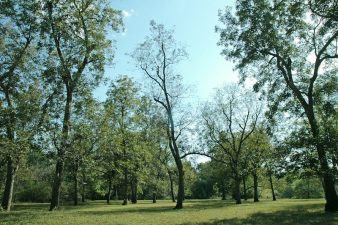
A Short Drive, A Chance to Scout the Native Crop
I was driving along backroads through native pecan groves when I came across a stopped pickup and a guy standing out in the middle of the road with a pair of binoculars trained on the upper branches of nearby trees. Turns out, I interrupted a pecan buyer trying to get a feel for the nut...
Read more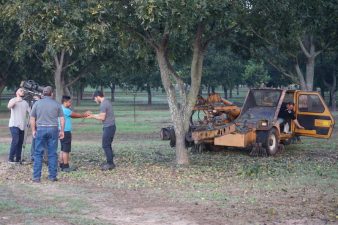
Industry Updates & Happenings
HOW IT’S MADE, OCT. 2017— While filming the harvesting process at Sorrells Farms, the film crew worried over the possibility of standing in fire ants and asked the Texans present, multiple times, if they were. It’s safe to say, they escaped unscathed. (Photos by Blair Krebs) HOW IT’S MADE, OCT. 2017— Kinley and...
Read more